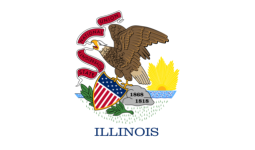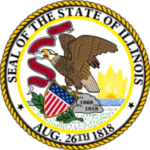Illinois
Illinois is a state located in the Midwest Region of the United States and is one of the eight states, along with the Canadian Province of Ontario, that make up the bi-national Great Lakes region of North America.
- ABBREVIATION: IL
- NICKNAME: Prairie State
- POPULATION: 12,882,135 (2013 est.)
- CAPITAL: Springfield
- STATE BIRD: Cardinal
- STATE FLOWER: Violet
- AREA: 57,914 sq. mi.
- TIME ZONE: Central
- ENTERED UNION: Dec. 3, 1818
- ALTITUDE: High, 1,235 ft. Charles Mound
- CLIMATE: Cold winters, hot summers; moderate rainfall.


With its multitudes of railroads, airlines, highways, not to mention 2 important rivers and an outlet on Lake Michigan, Illinois is the transit hub of the nation. Chicago, its biggest city, has been described by Carl Sandburg as “Tool-Maker, Stacker of Wheat, Player with Railroads and the Nation’s Freight Handler”. Because of its central location and its proximity to the Rust Belt and Grain Belt, Illinois is a national crossroads for air, auto, rail, and truck traffic.
As a growing meat-packing and grain center, Illinois early on began to construct transportation arteries for the shipment of its products. One of the first major links to the eastern markets was a canal built to connect the Illinois River and the southern half of the state to the Great Lakes, and through the Erie Canal, to New York City. This was followed in the 1850’s by the thundering arrival of the railroads, which-by bringing together raw materials, labor and market facilities-permitted heavy industry to thrive.
It was in Illinois that the extraordinary sea of grass called the Big Prairie was first encountered by white settlers. Accustomed to a thickly forested countryside, the pioneers of the early 1800’s hesitated to farm a land that seemed able to support only endless waves of six-foot-high grass. But beneath the tough sod their plows uncovered a deep treasure of mineral-laden soil left by the deposits of four continental ice sheets. The rolling prairies, stretching to the horizon with few obstructing outcrops of rock, were ideally suited to the use of harrows, cultivators and reapers, which eventually revolutionized food production.
In Illinois, the 20th Century exodus from the fields to the city has been dramatic. Only a small percentage of Illinoisans now live on farms. Nevertheless, with modern mechanized farming techniques, the land still yields enough to make the state one of the highest ranking states in the U.S. for farm income and food production.

The state has been called “a working model of the nation as a whole”, Illinois has an impressive economic balance. It has large farms and profitable industries with hundreds of thousands of employees, as well as one-family dairy farms and small electronic workshops. Although the single family farms are diminishing with time, Illinois still reflects the basic structure of the American way of life.
FUN FACTS:
- Illinois was the first state to ratify the 13th Amendment to the U.S. Constitution, which made slavery illegal.
- On St. Patrick’s Day the Chicago River is dyed green.
- Between 1910 and 1930 Chicago’s African-American population grew to nearly a quarter million, as the Great Migration brought black workers from the agricultural South to industrial cities in the North.
- Chicago is home to the world’s first Skyscraper, built in 1885.
- Chicago’s nickname ‘Windy City’ came from Charles Dana, editor of the New York Sun, who grew tired of hearing Chicagoans boast about the Columbian Exposition-the Chicago’s World’s Fair of 1893.
- The first controlled atomic chain reaction took place on a squash court at the University of Chicago in 1942 under the direction of physicist Enrico Fermi.
